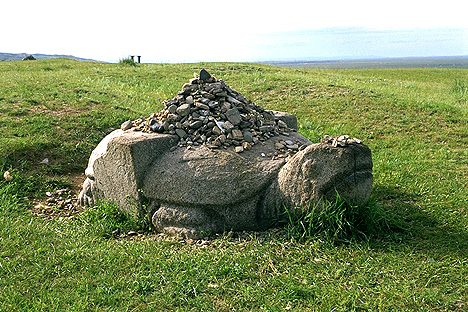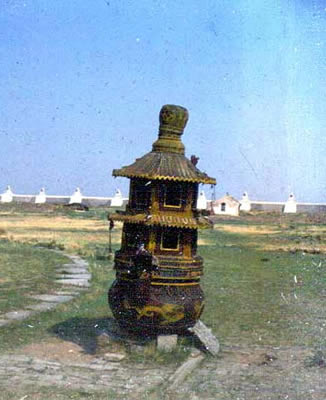
Stone Tortoise, Khara Khorum (detail),
Photograph by Kikutake Yuji,
Courtesy of VisitMongolia.com
Khara Khorum, the First Mongol Capital
A bronze lantern, a couple of stone tortoises, and the foundations of several buildings are all that remain of the first Mongol capital city, Khara Khorum.
Designated as the site of the empire's capital during Chinggis Khan's reign, the city was actually constructed during the reign of his son and successor Ögödei, who ruled from 1229 to 1241.
Ögödei recognized that the Mongols needed a capital if they sought to rule the vast empire they had conquered. But Khara Khorum turned out to be a poor location for a capital city, primarily because it could not supply itself. According to one Western observer, 500 carts of provisions were required daily to sustain the city's population. In 1267, Khubilai Khan moved the capital to Daidu (present-day Beijing), partly to reduce the expenses of supplying the center of the Mongol world.
The Franciscan missionary William of Rubruck visited Khara Khorum at its height in 1253-1255 and offered a splendid description of the palaces and what they contained (including a unique silver wine and koumiss vessel built by Guillaume Boucher, a Frenchman captured by the Mongols), as well as of numerous other buildings and artifacts in the city.
Russia excavated the remains of Khara Khorum in the 1930s and 1940s and found coins, Chinese bronzes and ceramics, and tiles, all of which they sent to the Hermitage in Leningrad.

Bronze Lantern, Khara Khorum (detail),
Photograph
by Morris Rossabi
A bronze lantern, a couple of stone tortoises, and the foundations of several buildings are all that remain of the first Mongol capital city at Khara Khorum. Designated as the site for the capital of the Mongol empire during Chinggis (Genghis) Khan's reign, the city was actually constructed during the reign of his son and successor Ögödei.
The Franciscan missionary William of Rubruck visited the town at its height (ca. 1253-1255) and offered a splendid description of the palaces, of a unique silver wine and koumiss vessel built by Guillaume Boucher (a Frenchman captured by the Mongols), and of numerous other buildings and artifacts in the city.
The Russians excavated the remains of Khara Khorum in the 1930s and 1940s and found coins, Chinese bronzes and ceramics, and tiles, which they sent to the Hermitage in Leningrad. This bronze lantern is one of the few objects to remain on site.
For William of Rubruck's account of his visit
to Khara Khorum:
• The Mission of Friar William of Rubruck, edited
by Peter Jackson and David Morgan (London: The Hakluyt Society, 1990)
— especially pages 172-181, 209-216, 221-225
For Marco Polo's account of life in Khara Khorum:
• Marco Polo, by A.C. Moule and P. Pelliot (London,
Routledge, 1938), pp. 161-62
• The Book of Ser Marco Polo: The Venetian Concerning Kingdoms and Marvels of the East, 3rd Edition, translated and edited by Colonel Sir Henry Yule (London: John Murray, 1903): "Chapter XLVI: Of the City of Caracoron" — Read this chapter online [PDF]